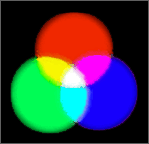|
Your
eyes are most sensitive to light in the middle of the visible-wavelength
spectrum-in the yellow and green. Near the edges of the spectrum, the
far red and violet light, your eyes are not especially sensitive. This
can produce the illusion of violet and red objects seeming to be black.
In dim light color is washed out for two reasons:
1.
red and violet (and blue, also) tend to look black, dark brown, or very
dark blue
2. the sensors in your eyes that respond to color do not function very
well in dim light.
Colors
are known to have effects on your mood. Blues and greens tend to
enhance the peacefulness of a setting. This might partly explain why
people go to the lakes, beaches, mountains, woods for relaxation. Natural
colors and natural shapes are relaxing to look at. For depression, bright
colors can help to cheer people up; yellows and pinks are often used
in hospitals to counteract the naturally dreary atmosphere of the place.
When you speak of ‘looking at the world through rose colored glasses,”
you do not often think of the psychological effect that prolonged exposure
to the color pink might have in some people.
Psychologists are involved in studying the effects of various colors on people’s dispositions. Colors can even tell us about personality. A house furnished in the tan and brown ‘earth tones” is generally regarded as masculine, while orange, pink, red, and yellow, along with white and other light shades are colors more often chosen by women.
Color Systems
The color systems used by scientists and artists are entirely different.
An artist will mix blue and yellow paint to get a shade of green; a
scientist will mix green and red light to create yellow, and a printed
page in a magazine is yet another system.
There Are Two Different Kinds of Color in the World.
First, there's the color you can touch, such as the skin of an apple or a painted wall. These colors are part of the surface of an object.
Next, there's the color you can't touch, such as a beam of red light and the colors produced by your computer monitor. Colors generated by light are part of one color system. The tangible colors which are on the surface of objects or on the printed page are another color system.
The following illustrations and descriptions define the different color systems.
 |
Scientists recognize the light primaries of red, green, and blue. When combined, red and green light rays produce yellow, blue, and green produce cyan, red and blue produce magenta. Red, green, and blue mix to create white (light).
Color Context
In addition to basic definitions of color and color harmony, how color behaves in relation to other colors and shapes is a complex area of color theory.
Compare the contrast effects of different color backgrounds for the same red square.
 |
Red appears more brilliant against a black background and somewhat duller against the white background. In contrast with orange, the red appears lifeless; in contrast with blue-green, it exhibits brilliance. Notice that the red square appears larger on black than on other background colors.
Different readings of the same color
 |
iIf your computer has sufficient color stability and gamma correction, you will see that the small purple rectangle on the left appears to have a red-purple tinge when compared to the small purple rectangle on the right. They are both the same color. This demonstrates how three colors can be perceived as four colors.
Brightness & Color Influence Distance Perception
These letters are all located on the same plane. But do all the Z's appear to be in the same plane or do some appear closer than the others?

| [ home| perception| depth perception| context effects| 3D vision ] |
| [ autostereogram| effects of color| optical illusions| visual illusions ] |

